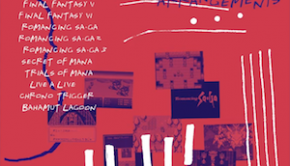The Epic of Zektbach -Masinowa-
 |
Album Title: The Epic of Zektbach -Masinowa- |
| Record Label: Konami Digital Entertainment |
|
| Catalog No.: GFCA-273/4 |
|
| Release Date: April 6, 2011 |
|
| Purchase: Buy at CDJapan |
Overview
The Epic of Zektbach -Masinowa- is the second original album by Tomosuke Funaki under his Zektbach alias, and third album under the alias overall. As before, the album contains a number of new compositions as well as extensions of tracks that have already been released through various Bemani games. Where his first album –Ristaccia- featured European influences in his unique blend of dark orchestral elements with electronic backdrops, –Masinowa- is distinctly Asian in flavour. This affects the composition as much as the arrangement, and results in a fresh new Zektbach experience that any fan should be happy to hear.
Body
The album begins with a non-game track, “Masinowa”, though it actually first appeared in piano arrangement form at the end of The Epic of Zektbach -Piano Collection-. The track sets up the album’s setting nicely by ushering in the many new oriental influences that permeate the album. The influences blend in well with the elements carried over from the first album, such as the orchestral elements and the occasional techno synths and rhythms. The textures are pretty varied throughout this first track, but I did feel that it meandered a bit at times and the melody was a bit repetitive. Other new instrumental tracks are similar, but a bit more interesting like “Junaguni Ruins” with its few retro synths mixed into heavy and spacious percussion. It doesn’t end up doing much, but it has a strong atmosphere throughout. “Sazaragi” brings up the energy with a more tropical sound and a frantic atmosphere, but it too feels just a tad repetitive. Then there is “Nunc omnia rident” later on which has a choral opening that leads to a piano with backing strings. The choir and strings hold the track back a bit with their cheaper sound, but the piano mostly makes up for it with its intrigue and emotion. The piano gets a better showcase in “Charcol’s Sword Dance”, which like the other “Sword Dance” tracks before it is a virtuosic and chaotic piano piece. There’s not too much unexpected here, but it’s another great track that demonstrates Funaki’s varied talents.
The more interesting new tracks are the ones with vocals. As a whole, there are more vocal tracks on –Masinowa- than on –Ristaccia-, and it helps the diversity of the album. “Omifushisama” has quiet and almost child-like vocalist yoko singing throughout in what sounds like an old and magical folktale, helped by her delivery and the inspired arrangement. It’s a captivating song that is perfect for the alias and the lore that it brings. ”The Sealer” is similarly rich with Chie Fukami’s nuanced and exotic vocal. The arrangement has a lot going on in it and seems to be constantly evolving, moving from its gorgeous and dreamy piano flourishes to the haze of backing instruments. It is also one of Funaki’s more interesting compositions, and easily merits several revisits. “Malchut” is much more simplistic than these, from vocalist crimm exclusively singing “la”s throughout the track to the instrumentation which centres on the harp and only occasionally pulls in assistance from others. It’s not as engaging on its own, but it fits in on the album, and it has a decent melody.
As usual, a few of the tracks are extended versions of tracks that already appeared in various Bemani games. It happens that these are all vocal tracks, and are among the strongest on the album. “Kagachi” is an ominous and furiously dramatic track that sounds first like a battle theme, but then changes into something very different in its second half. Funaki slows down the arrangement a bit and adds in Yayoi Yula’s enka vocals where there was originally only an instrumental melody. The decision is really a great one, as Yula’s vocals are very moving and emotional, heightening what was already a very strong track. Yula returns for “Wenkamui”, which opens innocently enough with some chanting and tribal rhythms before suddenly descending into dark rock territory reminiscent of Asaki’s works. Yula really sells her feverish and almost manic vocal on this track, while the arrangement shifts under her from grungy segments to ones that are quite beautiful with a string quartet, guitar, and piano. The extension allows for the track to complete its journey, and gives it enough to time to feel like a cohesive whole despite its unpredictable composition, rather than the mess that it could have been.
The other two returning vocal tracks have different vocalists. Upping the electronic influences is the wonderful “Raison d’être”, which sounds more in line with -Ristaccia- material with its furious strings, whirling harpsichord, and strong driving beat. Akiko Shikata sings on this track with a choir to solidify its epic feel. The extension doesn’t add much, but that’s fine for the busy track. “L’avide” sees the return of yoko’s soft vocal. The track begins simply with the vocal and some atmospheric strings, but soon Funaki brings in a fuller and faster paced arrangement. The track has a really great momentum, and I love the simpler instruments that pervade the track but don’t try to claim the spotlight, like the acoustic guitar, flute, and piano. It’s a pretty magical track with a great melody as well, and yoko’s vocals again tell a story, although this time one that is a bit more energetic. Overall, very strong work from the vocal tracks, even outshining most of the material on the first album.
The final five tracks on the album are orchestral arrangements by Taro Makido (while Osamu Kubota was the one who handled the orchestral arrangements that ended -Ristaccia-). Four of the five tracks were tracks from -Ristaccia-, while two of those already received orchestral arrangements. Thankfully Makido adds a new emphasis on choral elements (with a real, full choir here) making these worth hearing. The first is “Trisagion”, which is actually an arrangement of “Blind Justice”. Structurally it does not follow the originally very closely at all, and opts instead for a slower, more meditative approach to the track. It’s not a bad interpretation, but it’s not as good as the original. “ZETA” on the other hand is leagues above Kubota’s interpretation, since its vocals are sound much better and more full than Kubota’s male choir, and it goes for a more epic and grabbing sound that pays of well at the end. “Turii ~Panta rhei~” is also fairly straightforward and a bit slower, taking a bit of its power away. I appreciate the bigger sound that it has, but its not much more than that. I prefer this new version of “Malchut” to Funaki’s original, as the vocals sound better, the piano provides a richer accompaniment, and the other instruments sound more real. Closing out is a new version of “Aria te’Laria”, which is very faithful to the original, and is more like a remastering of the track. It sounds a bit grander, but I’m afraid it doesn’t do much for me, just like with the original. Still, as a whole I find this section to be stronger than what was provided at the end of -Ristaccia-, and it’s a nice close to another wonderful Zektbach album.
As a bonus, the album also includes a short DVD featuring the game animations for “ZETA”, “Raison d’être”, “Apocalypse ~memento mori~”, and “Kagachi”. These are still the short original versions and not the extended album versions of the tracks. They’re neat inclusions, and I found them more compelling than the ones included on -Ristaccia-, being better animated for the most part and a bit more psychedelic in its visuals. There is again a lot of narrative to be found for anyone willing to put the time into studying Funaki’s world, but these videos are still enjoyable without knowledge of the lore.
Summary
The Epic of Zektbach -Masinowa- sees a bit of a shift in Funaki’s alias as he takes on a different locale, for the most part ditching the electronic influences and taking up traditional and oriental influences. The result is a refreshing but still distinctly ‘Zektbach’ album, full of epic arrangements and a strong narrative setting. The increase in vocal tracks is a plus for the album, as these are the strongest tracks of the album. I feel like the album as a whole also feels more mature than the first album did, and likely will appeal to a broader audience. It is certainly worth it for any fans of Funaki’s older work under the alias, but many other listeners may want to check this album out too.
Do you agree with the review and score? Let us know in the comments below!
4.5
Posted on August 14, 2015 by Christopher Huynh. Last modified on August 14, 2015.














